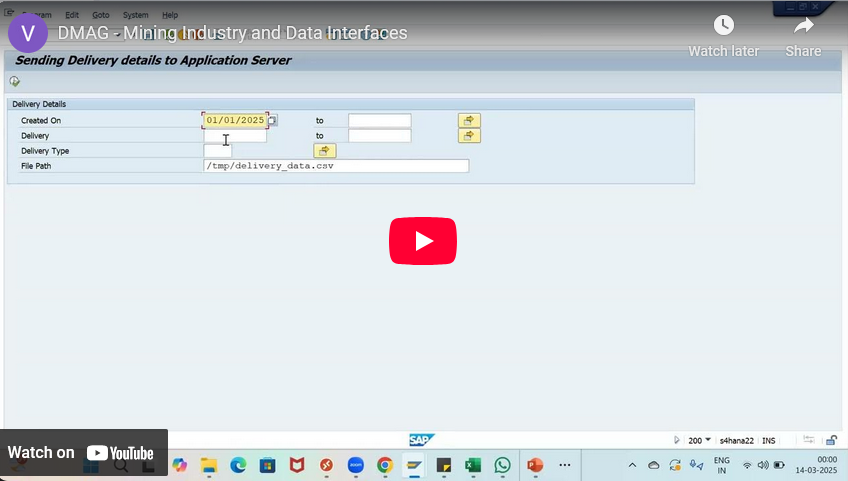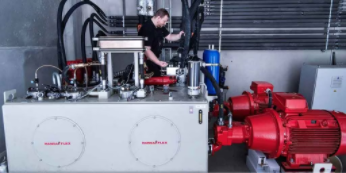By Alex Soto, Editor, SAPinsider
Walk into any stylish bathroom in Europe and you may unknowingly encounter innovative tiles and bathroom products manufactured by the Eczacıbaşı Group. The company's most popular ceramic sanitary brand VitrA has a global footprint.
With a growing international distribution network for its building products, and after many years of heavy acquisition activity, Eczacıbaşı Building Products embraced a digital transformation with a big picture vision: to become more agile and boost the customer brand experience.
"The fundamental aim was to leverage a holistic program that optimized and digitized core business processes, from planning to production," Alp Guldur, IT Director and Digital Leader of Eczacibasi Group Building Products Division, says.
SAP S/4HANA was selected as the technical core to achieve this end and connect all areas of the business.
Eczacıbası Building Products also partnered with Deloitte to launch the digital transformation program to connect business objectives with SAP technology.
According to Guldur, the in-depth evaluation by Deloitte was the most important part of their success. The architecture and feature roadmap developed by Deloitte was the key to completing the program quickly and efficiently.

The journey started in 2019 with a tailored engagement plan. SAP Enterprise Support guides provided expertise to help in areas such as data migration methodologies, continuous quality checks, and SAP Best Practices.
The overall business value is enhanced by SAP’s cloud solutions – including SAP Commerce Cloud, SAP Sales Cloud, SAP Marketing Cloud, SAP Service Cloud, and SAP Field Service Management. These SAP solutions have helped increase cross-sales functionality, automating processes, and enabling sales and marketing teams to listen to customers on social media, according to Guldur. Users are also more effective in generating leads and finding up-sell opportunities, he says.
The project, aptly named Project VitrAmax after the company's most popular brand, included a roadmap, desired business outcomes, and technologies to be used to lay the groundwork for digitally transforming the business.
Getting a snapshot of what's most important
According to Guldur, the project had a rich scope and a demanding deadline. It included more than 350 dedicated persons: 100 consultants and 250 internal team members.
"Organization was key," Guldur says. "When building out the scope of a large transformation project with hundreds of stakeholders, organizations need a detailed plan that connects the project teams with experts and partners."
Inputs of five different companies across four locations – Turkey, Germany, England, and France – were gathered. This process also meant working with individuals across various time zones in four different languages.
On top of the scope, timeline, and language complexities, the project team then had to navigate through the obstacles posed by the COVID-19 lockdowns.
With so many people involved from different backgrounds and time zones, it was vital to clarify the process and expectations every step of the way, according to Guldur.
"We created detailed roadmaps for every process, straightforward business models, clear key performance indicators (KPI), and capabilities categorized for every department," he says.
[caption id="attachment_32852" align="alignnone" width="293"]
 Alp Guldur, IT Director and Digital Leader, Eczacibasi Group Building Products Division
Alp Guldur, IT Director and Digital Leader, Eczacibasi Group Building Products Division[/caption]
Eczacıbası Building Products, together with consulting partners Deloitte and SAP Turkey, determined what was needed, from the inside and out in four months, to launch the digital transformation project.
They started breaking down the overarching goal of digital transformation into digestible components to make the project more manageable. According to Guldur, this also provides opportunities for teams to enjoy success, motivating individuals throughout a long project.
Input from all the stakeholders was vital in this process, so Guldur asked stakeholders about where they were and their vision for the next three years. The project team collected feedback from power users across logistics, sales, e-commerce, and finance teams. Power users consisted of subject matter experts and individuals in the company responsible for all training activities, testing, master data preparation, and more. The perspectives provided by these stakeholders helped determine the technical architecture requirements in each area.
Additional actions included running extensive reports, performing on-site supply checks, and conducting surveys and interviews with customers, showroom dealers, and other stakeholders to uncover opportunities for improvement throughout the project.
For example, test processes were complicated and hard to follow for the project team, according to Gamze Senkal, Eczacıbası Building Products Division Project Manager. “Test processes were designed collaboratively to optimize testing effectiveness,” she says.
In another example, Senkal describes the use of agile methodology to implement SAP technology modules. “In every sprint, we received feedback from our project and business team and made adjustments according to their comments,” Senkal says.
Senkal explains that to create a powerful team and centralize project management, a program management office (PMO) needed to be established. The PMO was comprised of a program manager, a project manager, and IT and business leaders.
[caption id="attachment_32855" align="alignnone" width="258"]
 Gamze Senkal, Eczacıbası Building Products Division Project Manager
Gamze Senkal, Eczacıbası Building Products Division Project Manager[/caption]
“We scheduled weekly PMO meetings, project team meetings, and periodic update meetings for the entire project team,” Senkal says. “We collected all inputs from the team, evaluated all ideas, and made final decisions with a steering committee on a monthly basis.”
Through surveys and interviews with customers, showroom dealers, and others the team enabled stakeholders to get a snapshot of the project, while enabling the project team to prioritize critical goals throughout the project.
When it came time for implementation, the teams knew how to approach the project.
IT enables digital transformation, but the business owns the project
Projects within SAP S/4HANA deployment programs can sometimes require a greenfield implementation, as was the case for Eczacıbası Building Products. In these types of implementations, the chances of something falling through the cracks is great, Guldur explains.
The project team developed a plan with journey checks built in to reduce the impact of potential project issues. They also developed a change management plan that brought together different groups, including the project management office, IT, sales, operations, and finance, to form the change management board.
Leaders from each group met for two hours every week to discuss issues. When a problem arose without a clear solution, the board decided how to pursue a resolution.
There was a critical risk management component in the project as well. Every month, Guldur and Senkal would hold one-to-one meetings with the company's CEO to exchange ideas on minimizing risks and conflicts throughout the journey.
The group also participated in must-know webinars and live interactive sessions, which enabled them to bring the project team to connect with SAP experts.
A key theme throughout the project was that IT enabled the project, but the businesses owned it. The businesses were responsible for defining the KPIs, which made them accountable for the project's success.
"It may be a cliché, but it worked," Guldur says. "Otherwise, we would not have been able to finish the project on time."
Putting the pieces together for a successful go-live
The SAP S/4HANA implementation for Eczacıbası Building Products consists of 19 different modules. These SAP solutions enhanced the overall business value by increasing cross-sales functionality, automating processes, and enabling sales and marketing teams to listen to customers on social media, according to Guldur. Users are also more effective in generating leads and finding up-sell opportunities, he says.
Implementing a custom code control mechanism running ABAP test cockpit to control code quality was a key to putting it all together, according to Senkal. Additionally, the team used SAP Fiori to standardize processes and create customer-friendly screens, improving customer and employee satisfaction.
The project team created applications and extensions in the cloud to automate master data for various functions, from costing and finance to customer-facing groups such as sales and marketing. The project team also reduced the number of Ztables while optimizing reporting capabilities.
Guldur refers to Ztables when explaining that many custom functions or tables were built into their existing SAP system. Ztables are created when standard SAP tables do not satisfy an organization’s data requirements. According to Guldur, there were hundreds of these tables.
"Users now have all the reports available and we killed hundreds and hundreds of Ztables," he says.
Users can now access a cockpit to see detailed transportation costs for each country and analyze how much it would cost to send products by land or sea. On top of that, SAP BW/4HANA provides real-time insight and allows a harmonized view of data for analysis.
After 13 months, the project went live across all operations of the company.
Immediate benefits included improving the production and shipment of their offerings, including more than 10,000 stock keeping units (SKU). For example, before the digital transformation initiative, Eczacıbası Building Product could ship 300,000 pieces in a month. Shortly after the project went live, the company was able to ship 430,000 pieces without adding a single headcount in the warehouse.
What Does This Mean For SAPinsiders?
- Spend as much time as needed to plan ahead. Before starting on a new digital transformation journey, create a detailed architecture and roadmap to help ensure a quick and efficient project.
- Break down large digital transformation initiatives into digestible components. When hundreds of stakeholders have a say in determining project goals, implementation teams will benefit from knowing the precise action steps to take, which tools to use, proper timing, and expectations. Providing this guidance to technical teams helps ensure successful project outcomes.
- Digital transformation is primarily a business-driven effort. While technology is a vital component of digitally transforming business, program outcomes do not fall solely on IT. The business must take a proactive leadership role in setting the agenda and expectations.
- Establish a mechanism to address change and risk. Executives typically see digital transformations from a high-level business perspective. They may need guidance and clarity on what technical problems can arise throughout the project. Change and risk management help bring these issues into view and enable faster decision-making to solve the potential issues before they become headaches.
Watch a short video to learn how the Eczacıbaşı Group broke down its large-scale digital transformation project into digestible components and use SAP S/4HANA as its technical core to connect all areas of the business.
 The journey started in 2019 with a tailored engagement plan. SAP Enterprise Support guides provided expertise to help in areas such as data migration methodologies, continuous quality checks, and SAP Best Practices.
The overall business value is enhanced by SAP’s cloud solutions – including SAP Commerce Cloud, SAP Sales Cloud, SAP Marketing Cloud, SAP Service Cloud, and SAP Field Service Management. These SAP solutions have helped increase cross-sales functionality, automating processes, and enabling sales and marketing teams to listen to customers on social media, according to Guldur. Users are also more effective in generating leads and finding up-sell opportunities, he says.
The project, aptly named Project VitrAmax after the company's most popular brand, included a roadmap, desired business outcomes, and technologies to be used to lay the groundwork for digitally transforming the business.
The journey started in 2019 with a tailored engagement plan. SAP Enterprise Support guides provided expertise to help in areas such as data migration methodologies, continuous quality checks, and SAP Best Practices.
The overall business value is enhanced by SAP’s cloud solutions – including SAP Commerce Cloud, SAP Sales Cloud, SAP Marketing Cloud, SAP Service Cloud, and SAP Field Service Management. These SAP solutions have helped increase cross-sales functionality, automating processes, and enabling sales and marketing teams to listen to customers on social media, according to Guldur. Users are also more effective in generating leads and finding up-sell opportunities, he says.
The project, aptly named Project VitrAmax after the company's most popular brand, included a roadmap, desired business outcomes, and technologies to be used to lay the groundwork for digitally transforming the business.
 Alp Guldur, IT Director and Digital Leader, Eczacibasi Group Building Products Division[/caption]
Eczacıbası Building Products, together with consulting partners Deloitte and SAP Turkey, determined what was needed, from the inside and out in four months, to launch the digital transformation project.
They started breaking down the overarching goal of digital transformation into digestible components to make the project more manageable. According to Guldur, this also provides opportunities for teams to enjoy success, motivating individuals throughout a long project.
Input from all the stakeholders was vital in this process, so Guldur asked stakeholders about where they were and their vision for the next three years. The project team collected feedback from power users across logistics, sales, e-commerce, and finance teams. Power users consisted of subject matter experts and individuals in the company responsible for all training activities, testing, master data preparation, and more. The perspectives provided by these stakeholders helped determine the technical architecture requirements in each area.
Additional actions included running extensive reports, performing on-site supply checks, and conducting surveys and interviews with customers, showroom dealers, and other stakeholders to uncover opportunities for improvement throughout the project.
For example, test processes were complicated and hard to follow for the project team, according to Gamze Senkal, Eczacıbası Building Products Division Project Manager. “Test processes were designed collaboratively to optimize testing effectiveness,” she says.
In another example, Senkal describes the use of agile methodology to implement SAP technology modules. “In every sprint, we received feedback from our project and business team and made adjustments according to their comments,” Senkal says.
Senkal explains that to create a powerful team and centralize project management, a program management office (PMO) needed to be established. The PMO was comprised of a program manager, a project manager, and IT and business leaders.
[caption id="attachment_32855" align="alignnone" width="258"]
Alp Guldur, IT Director and Digital Leader, Eczacibasi Group Building Products Division[/caption]
Eczacıbası Building Products, together with consulting partners Deloitte and SAP Turkey, determined what was needed, from the inside and out in four months, to launch the digital transformation project.
They started breaking down the overarching goal of digital transformation into digestible components to make the project more manageable. According to Guldur, this also provides opportunities for teams to enjoy success, motivating individuals throughout a long project.
Input from all the stakeholders was vital in this process, so Guldur asked stakeholders about where they were and their vision for the next three years. The project team collected feedback from power users across logistics, sales, e-commerce, and finance teams. Power users consisted of subject matter experts and individuals in the company responsible for all training activities, testing, master data preparation, and more. The perspectives provided by these stakeholders helped determine the technical architecture requirements in each area.
Additional actions included running extensive reports, performing on-site supply checks, and conducting surveys and interviews with customers, showroom dealers, and other stakeholders to uncover opportunities for improvement throughout the project.
For example, test processes were complicated and hard to follow for the project team, according to Gamze Senkal, Eczacıbası Building Products Division Project Manager. “Test processes were designed collaboratively to optimize testing effectiveness,” she says.
In another example, Senkal describes the use of agile methodology to implement SAP technology modules. “In every sprint, we received feedback from our project and business team and made adjustments according to their comments,” Senkal says.
Senkal explains that to create a powerful team and centralize project management, a program management office (PMO) needed to be established. The PMO was comprised of a program manager, a project manager, and IT and business leaders.
[caption id="attachment_32855" align="alignnone" width="258"] Gamze Senkal, Eczacıbası Building Products Division Project Manager[/caption]
“We scheduled weekly PMO meetings, project team meetings, and periodic update meetings for the entire project team,” Senkal says. “We collected all inputs from the team, evaluated all ideas, and made final decisions with a steering committee on a monthly basis.”
Through surveys and interviews with customers, showroom dealers, and others the team enabled stakeholders to get a snapshot of the project, while enabling the project team to prioritize critical goals throughout the project.
When it came time for implementation, the teams knew how to approach the project.
Gamze Senkal, Eczacıbası Building Products Division Project Manager[/caption]
“We scheduled weekly PMO meetings, project team meetings, and periodic update meetings for the entire project team,” Senkal says. “We collected all inputs from the team, evaluated all ideas, and made final decisions with a steering committee on a monthly basis.”
Through surveys and interviews with customers, showroom dealers, and others the team enabled stakeholders to get a snapshot of the project, while enabling the project team to prioritize critical goals throughout the project.
When it came time for implementation, the teams knew how to approach the project.








